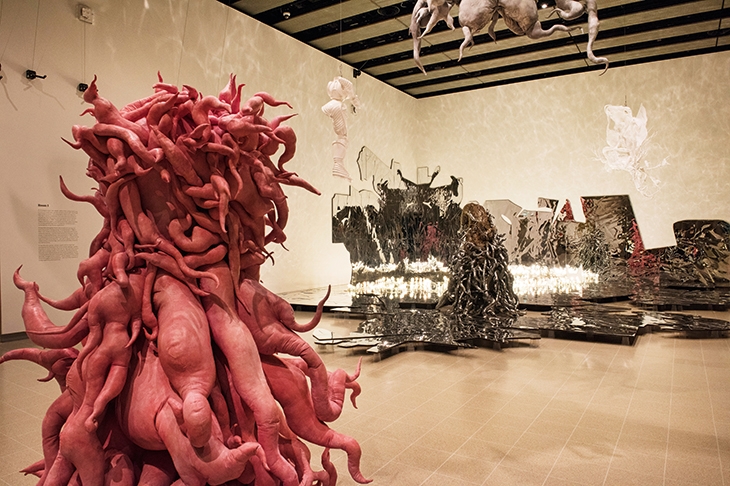One area of life in which globalism certainly rules is that of contemporary art. Installation, performance, the doctrine of Marcel Duchamp, conceptualism — nowadays these flourish throughout the world and nowhere more so than in the Far East.
Plenty of evidence for this is on view in an exhibition at the Hayward Gallery by the South Korean artist Lee Bul. But though the idioms are familiar, the works themselves can seem outlandish to an occidental eye.
Just inside the door you are confronted by a sculpture entitled ‘Monster: Pink’ (2011). It looks like one of those oddly shaped vegetables that are sometimes displayed at village fêtes — but running riot on a monumental scale and sprouting innumerable carrot-like tubers.
Lee Bul is good at making monstrosities. More dangle from the ceiling of the Hayward and thrust up from the floor — part human, part plant. Sometimes, from a mass of tendrils, a hand or a limb protrudes. Another type, dubbed ‘Cyborgs’, has apparently been fashioned from suits of sheet armour tailored for the female figure with sharply conical breast-plates and no heads. A third variety suggests that interbreeding has taken place between lobsters and machine tools.
These fantastic blends of the animate and inanimate are fun and, in a way that is reassuring for the historically minded, traditional. They fit into an oriental genre; it’s not hard to imagine them in the animated films of the Studio Ghibli, replete with magnificently weird flying machines and phantasmagorical Japanese goblins. For that matter, 18th-century Japanese painting abounds in bizarre bugaboos, and sometimes giant vegetables too.
But modernism is an oriental tradition too. The reverse of the proposition with which I began — that Western modernism has conquered the rest of the world — is that cutting-edge 19th- and 20th-century European art borrowed heavily from Africa and Asia. When you travel in Japan, you constantly come across pieces of ancient art or architecture that look as though they might have been made in the Bauhaus.
So it’s not surprising that the avant-garde and the Far East are a good fit. South Korea, in particular, has produced several important figures. Lee Ufan — roughly, in British terms, a blend of Richard Long and Howard Hodgkin — strikes me as a major artist. Before I saw the Hayward show, I wondered whether Lee Bul might be another. But I left unconvinced.
The monsters are the best of it. But there’s too much other stuff crammed in with them: the exhibition even extends over the outside of the building, which is covered by an almost indiscernible spider’s web of wires and glass beads, and into the lavatories. On the gallery walls, at intervals, there are accounts of modern Korean history and the position of women in Korean society. These are informative if you want to learn about the demilitarised zone or the rule of President Park Chung-hee — as in fact I did — but they add to the general feeling of overload.
If you’ve got a spare couple of hours, you can watch the artist’s early performance pieces — in which, for example, she struggles around in a monster-suit or dangles naked from a gallery ceiling — on a series of screens, though I wouldn’t really recommend the experience.
Her installations and sculptures include some phantasmagorical aerial cities that again recall Studio Ghibli, but they tend to overcomplication. ‘After Bruno Taut’ (2013), for example, is concerned with a early modernist German architect who advocated buildings made of glass extending, if possible, into outer space. Lee Bul’s fantasia on this theme looks like an insanely elaborate chandelier, festooned with beadwork.
In a funfair sort of way, ‘Via Negativa II’ (2014) is the most entertaining exhibit. This is an avant-garde labyrinth, a sequence of facetted, mirrored spaces in which you see yourself reflected from all angles. In the centre is a chamber in which the world seems to shoot off in every direction down an infinite tunnel of lights.
The outside of this construction is plastered with pages from The Origin of Consciousness in the Breakdown of the Bicameral Mind (1976), a work by an American psychologist named Julian Jaynes, reversed. The art maze is fine, though not the first I have wandered through. But the illegible text on the outside just made me think, ‘Oh no!’
Born in 1964, Lee Bul comes from the same generation as the young British artists of the 1990s, such as Tracey Emin and Damien Hirst. And like several YBAs she tries to do too many things and crams in too many ingredients. Minimalism is an oriental idiom too, but not one she follows.






Comments